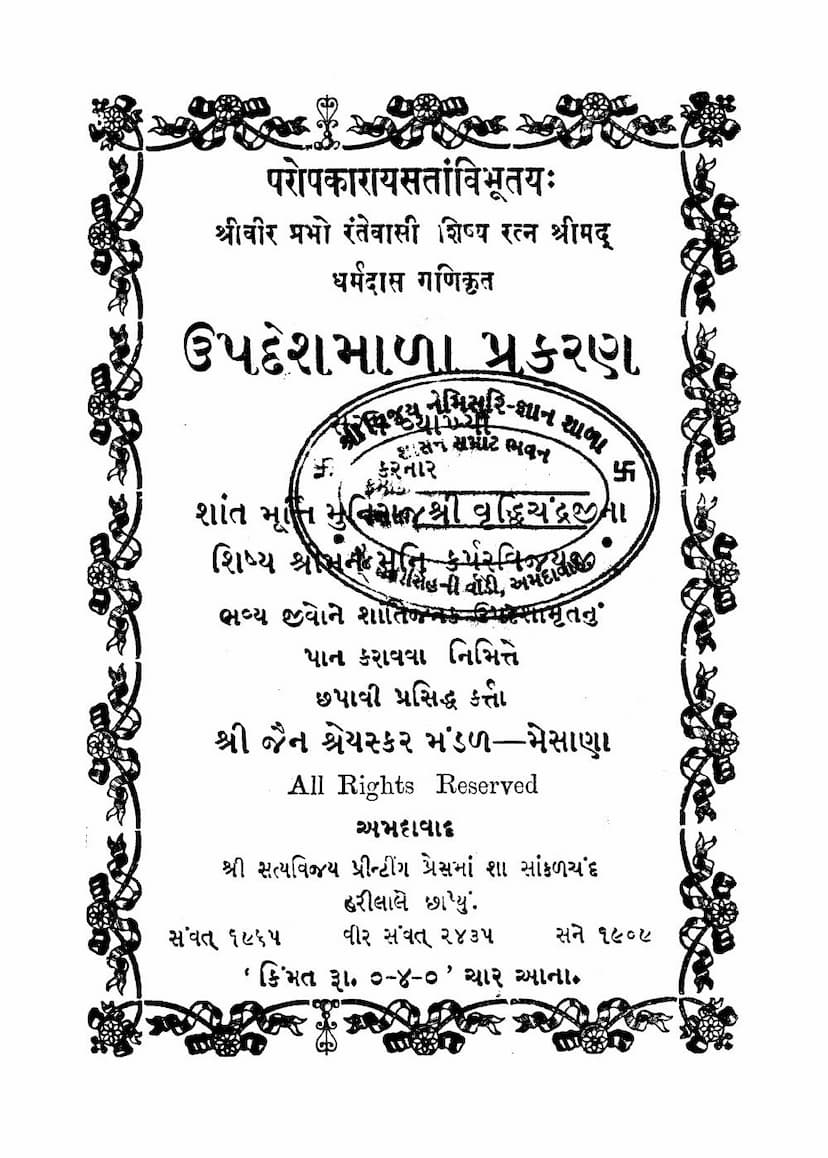Updesh Mala Prakaran
Added to library: September 2, 2025

Summary
The provided text is a summary and commentary on the Jain text "Updesh Mala Prakaran" (Collection of Teachings) authored by Dharmdas Gani and commented on by Karpurvijay. The Jain Shreyaskar Mandal, Mesana, published it in 1909 (VS 2435, 1965).
Here's a comprehensive summary based on the provided text:
Book Title: Updesh Mala Prakaran Author: Dharmdas Gani Commentary/Editor: Karpurvijay Publisher: Jain Shreyaskar Mandal, Mesana Publisher Date: 1909 (VS 2435, 1965)
Core Message and Purpose:
The "Updesh Mala Prakaran" is a significant Jain text composed by Shrimad Dharmdas Gani, a highly knowledgeable disciple of Lord Mahavira. The book's name, "Updesh Mala" (Garland of Teachings), accurately reflects its content, which is rich in spiritual guidance. The primary aim of the text is to impart essential teachings and principles of Jain dharma to a broad audience, helping them progress on the path to spiritual liberation (moksha).
Origin and Context:
The text was specifically written by Dharmdas Gani to enlighten his worldly son, Ran Singh Kumar. The introduction and opening sections provide a brief biography of Ran Singh Kumar, setting the context for the teachings that follow. The publishers, Jain Shreyaskar Mandal, have undertaken the task of making this ancient and valuable text accessible to the public, often at minimal cost, to combat ignorance and guide people towards the righteous path.
Key Themes and Teachings:
The "Updesh Mala Prakaran" covers a vast array of topics crucial for spiritual aspirants, particularly monks and nuns, but also beneficial for lay followers (shravaks and shravikas). Some prominent themes include:
- The Importance of a Guru: The text emphasizes the indispensable role of a true guru in guiding disciples on the spiritual path. It highlights the qualities of an ideal guru (e.g., wisdom, eloquent speech, compassion, equanimity) and the necessity of unwavering devotion and obedience from the disciple.
- Discipline and Conduct for Monastics: A significant portion of the text is dedicated to detailing the expected conduct, virtues, and observances for Jain ascetics (monks and nuns). This includes:
- Vows (Vratas): Emphasis on the strict observance of vows, particularly the five great vows (mahavratas).
- Self-Control (Samiti and Gupti): Detailed guidance on practicing vigilance in actions (samitis) and controlling thoughts, speech, and body (guptis).
- Equanimity (Samata): The importance of maintaining equanimity in the face of pleasure and pain, honor and dishonor, and external hardships.
- Renunciation (Vairagya): Teachings on detachment from worldly pleasures and possessions, recognizing their transient nature.
- Austerities (Tapa): The significance of performing austerities for purification and spiritual progress.
- Avoiding Worldly Entanglements: Strong advice against forming attachments or excessive contact with householders or women, as these can lead to spiritual downfall.
- Qualities of a True Monk: Detailed descriptions of the virtues of a good monk, such as humility, patience, contentment, non-violence, and freedom from pride and ego.
- Dangers of Misconduct: The text warns against various transgressions and lapses in conduct for ascetics, highlighting the severe consequences of pride, attachment, and deviation from prescribed rules.
- The Nature of Karma: The book delves into the intricacies of karma, its binding, and its eventual shedding through righteous conduct and spiritual practices. It explains the consequences of actions and the slow but sure path to liberation.
- The Importance of Knowledge and Righteous Conduct: The text underscores that true spiritual progress is achieved through a combination of right faith (samyak darshan), right knowledge (samyak jnan), and right conduct (samyak charitra).
- Practical Guidance: The text provides practical advice on daily conduct, speech, and thought processes, encouraging mindfulness and adherence to Jain principles in all aspects of life.
- Critique of False Practices: The commentary also subtly addresses and cautions against superficial religious practices or the adoption of monasticism without genuine inner transformation and adherence to principles.
Structure and Style:
The "Updesh Mala Prakaran" is presented with a commentary that makes the original teachings more accessible. The text is rich in examples, parables, and anecdotes drawn from Jain lore and history, illustrating the principles being taught. The commentary includes various poetic forms like chappay and savaiya, making the spiritual message engaging and memorable.
Overall Significance:
"Updesh Mala Prakaran" is a foundational text that encapsulates the essence of Jain teachings for living a spiritually disciplined life. It serves as a comprehensive guide for understanding and practicing Jain dharma, emphasizing the path of renunciation, self-control, and devotion to achieve ultimate spiritual freedom. The publishers' effort to make it available to a wider audience is crucial for the dissemination of this vital spiritual knowledge.